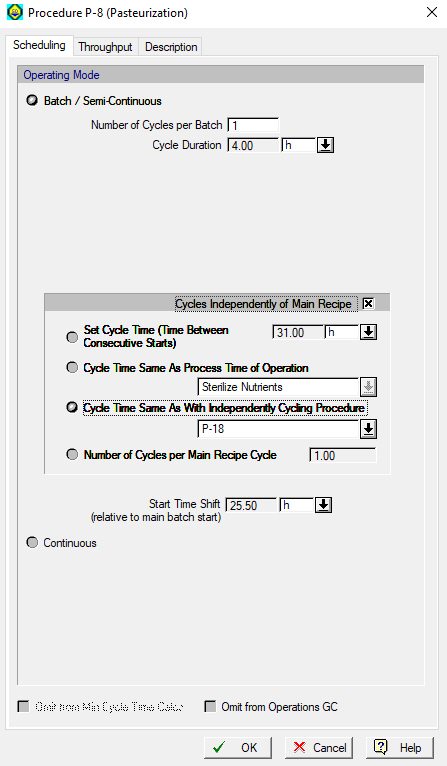

This tab is displayed when you select to show the procedure data dialog of any unit procedure in a continuous process flowsheet (i.e., the flowsheet’s process operating mode is ‘Continuous’).
When the procedure is in ‘Batch/Semi Continuous’ mode, the user may view the Cycle Duration and Start Time Shift (relative to time zero), and he/she may change the default specification option for the Holdup Time (or wait time). This is the time that this procedure accumulates material for processing in order to ensure that the overall process is continuous. It is used to determine how much material is processed per Cycle Duration of the procedure. There are three options for specifying the holdup time:
● Set by User
● Calculated
● Same As Process Time of Oper.
If the “Set by User” option is selected, then the user must set the holdup time value. Naturally, the specified value must be at least as large as the processing time of the step (i.e., the Cycle Duration), otherwise overall plant continuity is disrupted. If the “Calculated” option is selected, the program will assume a holdup time equal to the calculated Cycle Duration. Note that this option is only available if all operation process times are specified. If the “Same As Process Time of Oper.” option is selected, the user must select an operation from the list of available operations for this procedure, and the program will set the holdup time equal to the process time of that operation. Note that this list includes only operations whose process times are specified.
Note that in cases where the procedure is purely batch (batch by nature) (e.g. PBA Chromatography, Batch Microfiltration, etc.), the procedure cannot be switched to ‘Continuous’ mode, and therefore the holdup time must be specified at all times. If the process times of all contained operations are specified (as in Batch Microfiltration), then the procedure’s holdup time option is initially set to ‘Calculated’. Otherwise, if the process time of at least one contained operation must be calculated (as in PBA Chromatography), the procedure’s holdup time option is initially set to ‘Set by User’ and the holdup time is initially set equal to 24 hours.
If the holdup time is smaller than the cycle duration, then the consecutive cycles or executions of the sequence of operations in the procedure overlap, which will cause an equipment sharing violation (e.g., if you view the Equipment Occupancy Chart). In this case, the main equipment sharing conflicts may be resolved by setting extra sets of equipment in staggered mode (see Staggered Mode), but auxiliary equipment sharing conflicts can only be resolved by making the holdup time greater than or equal to the cycle duration. If the holdup time is smaller than the cycle duration, the ‘Extra Sets Required in Stagger Mode to Meet Cycle Time’ is displayed. This is the minimum number of extra sets of equipment in staggered mode required to resolve the main equipment sharing conflicts. When you click OK to close the procedure data dialog, the program offers to set the staggered equipment option on the equipment data dialog to ‘ON’ and set the extra sets of staggered equipment equal to the calculated minimum value, automatically.
For procedures in continuous mode, all these values are meaningless and we assume cycle duration and holdup time are 24 hours.
For more information on the time related values please, seeProcedure Cycle and Cycle Duration.
See Also:
● Procedure Data Dialog: Scheduling Tab (Batch Process)